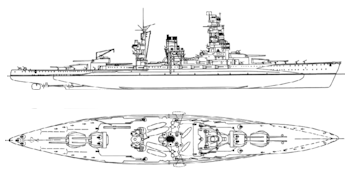



The Nagato-class battleships were the first to be built after World War I and also the first capital ships in the world to be armed with 16-in main guns. These were the 41-cm Type 3 that were the first large naval guns designed entirely in Japan (previous ones being British Vickers designs). They had been slated for numerous other planned battleship classes which were cancelled by the Washington Treaty. Secondary armament consisted of twenty 5.5-in guns arranged in casemates, while anti-air armament was quite varied, and was modified extensively after the two ships were reconstructed in the 1930s. The Nagato ships incorporated numerous other advances compared to their predecessors, particularly with regards to protection given the need to adopt the lessons from the Battle of Jutland. As such, the Nagato-class featured 'all-or-nothing' armor design, considerable underwater protection, and two armored decks. The turret armor was also significantly increased after the reconstruction and like existing classes, the Nagato ships received a new pagoda-style mast which included rangefinders and later, Type 21 air-search radars. Despite being the most powerful Japanese capital ships apart from the Yamato-class, the Nagato ships did not see extensive action during the early campaigns of World War II and in 1943, the Mustu was lost due to an internal explosion. The Nagato was the only Japanese battleship to survive the war afloat and as a result, was sunk as a target during atomic bomb tests.
The Nagato was the flagship of the Combined Fleet at the start of World War II, and it is where the order to attack Pearl Harbor was given. It was also present at Midway but did not see action until the Battle of the Sibuyan Sea, an early engagement during the Battle of Leyte Gulf. It suffered only light damage but was returned to Japanese waters and survived the war despite air attacks. It was then used for the atomic bomb tests at Einwetok in 1946, and was sunk during the second blast. Mutsu was also present at Midway as well as in Guadalcanal and the Battle of the Eastern Solomons. In mid-1943, while at anchor at Hashirajima, it suffered a catastrophic turret explosion, killing nearly three-fourths of its crew.
 | |
| Class | Nagato |
| Type | Battleship |
| Year | 1920 |
| Crew | 1333 |
| Dimensions | |
| Length | 201.4 m (pp) 213.4 m |
| Beam | 29 m |
| Draught | 9.1 m |
| Displacement | |
| Empty | 33,800 t |
| Loaded | 38,500 t |
| Performance | |
| Speed | 49 km/h |
| Range | 10,186 km @ 30 km/h |
| Machinery | |
| Shafts | 4 |
| Turbines | 4 x Geared steam 80,000 hp Gihon |
| Boilers | 21 x Kampon |
| Fuel | Oil: 3,400 t |
| Armament | |
| Main | 8 x 410-mm/45 (4 x 2) 41cm/45 Type 3 |
| Secondary | 20 x 140-mm/50 (20 x 1) 14cm/50 Type 3 -7° / +20° |
| Anti-Aircraft | 4 x 76-mm (4 x 1) 8cm/40 Type 41 |
| Torpedo tubes | 2x4 x (21-in) |
| Broadside | 8,160 kg |
| Armor | |
| Belt | 102 - 305 mm |
| Bulkhead | 254 - 330 mm |
| Deck | 38 - 76 mm |
| Barbettes | 229 - 305 mm |
| Gun turret | 127 - 356 mm |
| Conning tower | 102 - 356 mm |
| Production | |
| Built | 2 |
| Total | 2 |
| Ship | Code | Builder | Laid | Launch | Comm | Decomm | Fate | ||
 |
Nagato | Kure K K | 10/08/1917 | 09/11/1919 | 25/11/1920 | 15/09/1945 | Sunk as atomic target | ||
 |
Mutsu † | Yokosuka K K | 01/01/1918 | 31/05/1920 | 24/10/1921 | 08/06/1943 | † | Internal explosion/fire |